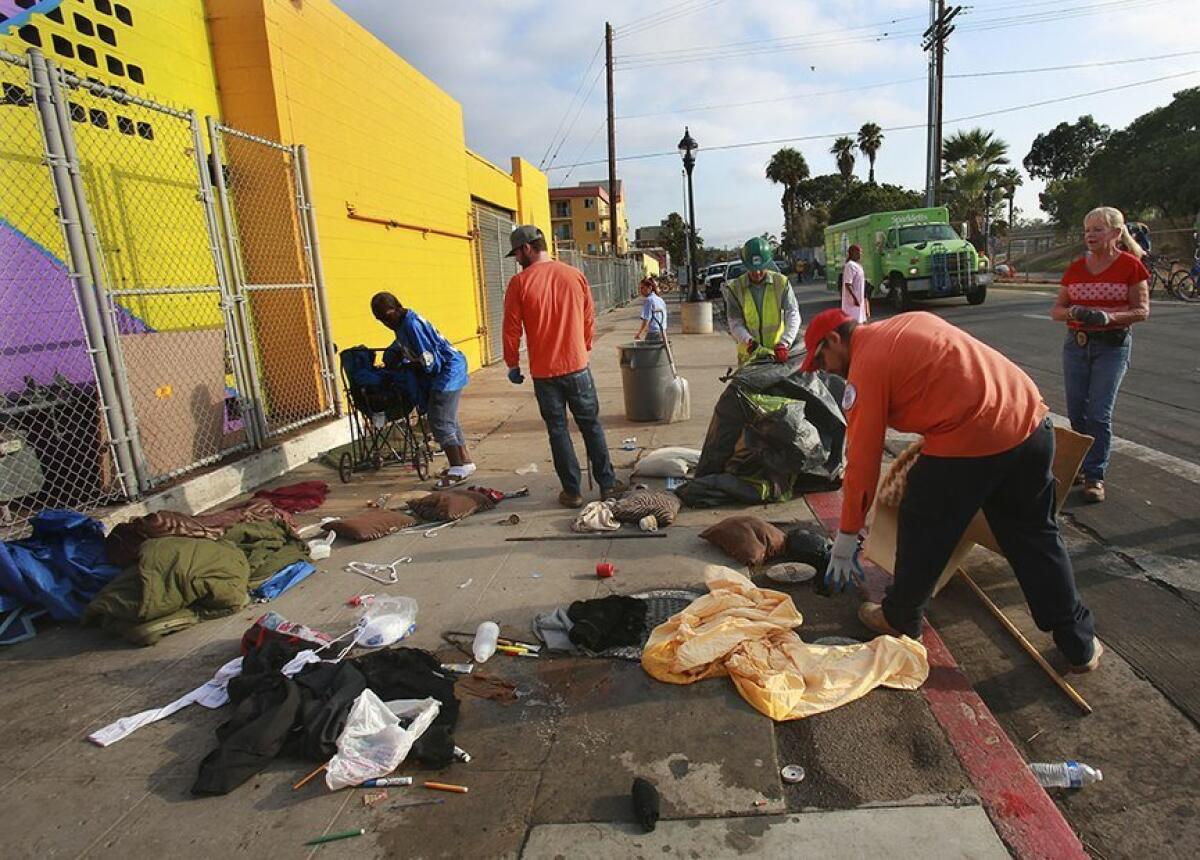Monday mornings mean moving for homeless population in San Diego

Reporting from San Diego — For Dion Anthony Miller and other homeless people who sleep on the streets of downtown San Diego, Monday is always moving day.
“To come out here every week, to me, it’s a form of harassment,” said Miller, who gets up at 3 a.m. to begin properly packing his possessions before a city cleaning crew arrives around 7.
Miller said he doesn’t see much sense in the weekly ritual that began in March, because the homeless people who are displaced return to the same sidewalks within hours.
The alternative, however, could be stench and trash left unchecked and growing on sidewalks near City Hall, Petco Park and long stretches of 17th Street, where Miller usually spends the night.
Every morning, I get up and police the area around my tent.... I don’t want to live in a junkyard.
— Homeless veteran John Taft
José Ysea, a public information officer with the city of San Diego, said the sweeps remove about 3 tons of trash and debris from the public right of way each week.
With the downtown homeless population at about 1,000 and the number of tents and other temporary structures up 70% this year, he said, the city no longer waits for calls to clean up an area.
“We used to be reactive,” Ysea said. “Now we’re proactive.”
The sweeps by the city’s Environmental Services Department — charged with enforcing codes relating to waste, dumping and litter on public property — include the area around the St. Vincent de Paul Village, Petco Park and the San Diego Concourse.
On Monday morning this week, one woman walked down 17th Street with a twin-size mattress on her head. Another had managed to fit an entire couch inside a cart and was attempting to roll it to a place where she could wait out the sweep.
“If you’re not going to help, could you move?” a woman said to somebody nearby as she worked to dismantle a tent as a city crew approached.
A woman next to Miller struggled to fold her tent, but decided to abandon it when something went wrong with the support rods. Like other things left behind, it would be picked up by workers from San Diego Urban Corps, a work-education program that helps Environmental Services with the sweeps.
Many people seem to have a routine down as they prepare for the sweep, and nobody is taken by surprise. As required by law, the city places notices in the area announcing each cleanup 72 hours in advance.
Still, many people this week rushed to salvage whatever they could. A mirror, a pair of rolled-up socks and other articles of clothes were among items left behind on one stretch of sidewalk.
“It’s astronomically hard,” John Taft, who is homeless, said about the weekly move. “Right now I have three shopping carts and a couple of boxes, besides a bike.”
Taft said he receives disability aid and had lived in an apartment that accepted housing vouchers for veterans, but became homeless in September after his landlord died and the man’s widow stopped taking vouchers.
While he’s waiting for another apartment, he has been sleeping on a dirt lot near the Neil Good Day Center for the homeless on 17th Street.
“We’re not doing anything wrong,” Taft said. “We’re on public land. There’s no sidewalk there. We’re on a piece of dirt. Every morning, I get up and police the area around my tent. I pick up all the trash, even out in the street. I don’t want to live in a junkyard.”
Homeless advocate Michael McConnell, who watches the sweeps almost every Monday, said he finds them pointless.
“It’s an incredible waste of taxpayer money,” he said. “Look at the resources we’re spending.”
McConnell said he understood that the city must do what it can to keep the area clean and safe, but was troubled by the times he has seen people warned or ticketed by officers — moves he said were akin to criminalizing homelessness.
“And the entire process, once complete, does nothing but move somebody to another neighborhood,” he said. “So we spend an incredible amount of money, and all we’ve done is relocate the problem.”
McConnell said the city should take other steps, such as placing garbage bins on the site to help people keep their campsites clean, while investing in permanent housing.
After Miller cleared out his belongs, he stood across the street and watched the cleaning crew.
“What makes it pointless is … we do a better job of sweeping than they do,” he said.
Miller said he routinely cleans the sidewalk and even sprays it for bugs to help other people sleeping there.
Nearby, the Neil Good Day Center was crammed with others who also had packed up everything they owned. Some already had returned to their old sites in the dirt or on the sidewalk, knowing the routine would be repeated next week.
Warth writes for the San Diego Union-Tribune.
ALSO
‘Catastrophic’ charter bus crash leaves five dead, L.A. driver seriously injured
Man shot by LAPD officer after ‘intense struggle’ at East Hollywood pharmacy, police say
Three bodies are found at crash site in Angeles National Forest during search for missing teens
More to Read
Sign up for Essential California
The most important California stories and recommendations in your inbox every morning.
You may occasionally receive promotional content from the Los Angeles Times.










